New York is a spectacular city. Cosmopolitan par excellence, here you’ll find a mosaic of cultures, histories and surprising corners that go far beyond the Statue of Liberty, Central Park, or the Empire State Building. The Big Apple hides secrets far beyond the must-see sights in Manhattan — secrets that even many New Yorkers are unaware of.
So, to avoid the same touristy fate, we’re going to tell you about 10 secrets of New York that you won’t want to miss on your next visit.
1. The Morgan Library: A hidden treasure in Midtown
One of the places least-visited by tourists is the Morgan Library & Museum. Located in the heart of Midtown, just steps from the bustle of Fifth Avenue, it’s an architectural and cultural gem. Founded by banker J.P. Morgan in the early-1900s, it houses books and documents of all kinds. There are original manuscripts by authors like Charles Dickens, Mozart’s scores, as well as letters from kings and popes.
If the contents weren’t brilliant enough, the building is equally impressive. Built between 1902 and 1906 adjacent to his residence, it was designed by architect Charles McKim in the Italian Renaissance palazzo style. Its main room — with painted ceilings and fine wood bookshelves — looks like something out of a movie. In fact, some people say that the famous library featured in the 1999 film Beauty and the Beast was inspired by the one belonging to J.P. Morgan (although this is an unconfirmed rumor).
 The Morgan Library & Museum, originally J. P. Morgan’s private library, was built between 1902 and 1906.Liao Pan ( China News Service / VCG /Getty Images)
The Morgan Library & Museum, originally J. P. Morgan’s private library, was built between 1902 and 1906.Liao Pan ( China News Service / VCG /Getty Images)
You can buy tickets from the museum’s official website ($25 per adult). And, if you find it a bit expensive, you can opt to enter for free on Fridays from 5:00 p.m. to 8:00 p.m., provided that you make a reservation.
2. The Cloisters: A medieval monastery in Manhattan
It sounds unbelievable, but a half-hour drive can take you from the heart of Times Square to the interior of a monastic European building, with views of the Hudson River. We’re talking about The Cloisters, a museum that’s part of the Metropolitan Museum of Art (Met). Containing a complex made up of cloisters and gardens, the stones were brought from Europe and reassembled. Romanesque columns, Flemish tapestries and many other notable works were also shipped from the Old World and installed. Europeans are perhaps more accustomed to them, but they’re usually harder for Americans to see.
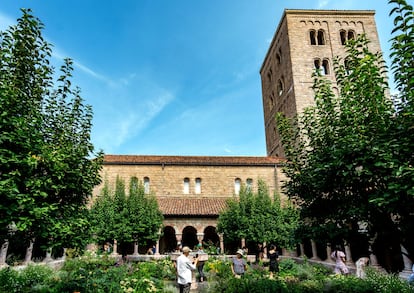 The Cloisters is located in Fort Tryon Park in New York City.Brian Logan ( Alamy /CORDON PRESS )
The Cloisters is located in Fort Tryon Park in New York City.Brian Logan ( Alamy /CORDON PRESS )
Admission to The Cloisters ($30) is included with your Met ticket. So, if you decide to visit one of the locations, you can also visit the other on the same day, without paying anything extra. Just be sure to keep an eye on the time, as The Cloisters isn’t exactly centrally located and closes at 4:30 p.m.
3. The haunted subway of Old City Hall
The Manhattan subway system is somewhat peculiar: its stations host everything from an “impromptu” Jimmy Fallon show with a guest artist, to the most common underground residents (rats). However, something that not many people know is that it hides a subway stop worthy of a period film: Old City Hall.
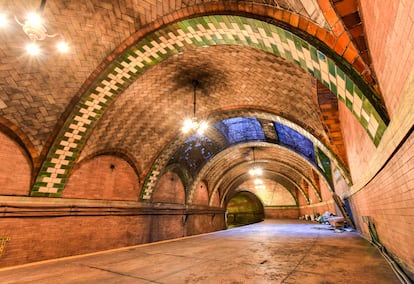 Old City Hall subway station platform.demerzel21 ( GETTY IMAGES )
Old City Hall subway station platform.demerzel21 ( GETTY IMAGES )
The station was inaugurated in 1904 and closed in 1945, but it still retains its original tiles, bronze lamps and a stunning glass dome. Unfortunately, it’s no longer open to the public, but there are still ways to visit it. The easiest option is through a tour organized by the New York Transit Museum. But if you can’t get a spot on a tour, you can also view it from the window of the 6 Train: instead of getting off at the last stop, you can wait for the train to do a loop. Then, you’ll see the historic station as you head in the opposite direction.
4. Hess’s Triangle: A family’s resistance to eminent domain 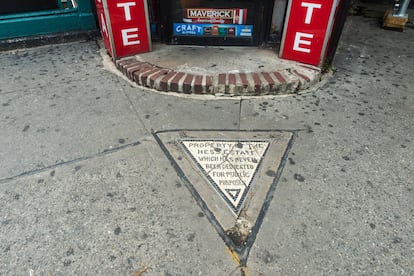 The Hess Triangle, on the sidewalk in front of Village Cigars, in the West Village.Stacy Walsh Rosenstock ( Alamy /CORDON PRSS )
The Hess Triangle, on the sidewalk in front of Village Cigars, in the West Village.Stacy Walsh Rosenstock ( Alamy /CORDON PRSS )
You’ll need to keep an eye on the ground if you’re walking around the corner of Christopher Street and 7th Avenue in Manhattan’s West Village, as that’s where the Hess Triangle is located.
This piece of New York City has a rich history. Back in 1910, the city expropriated a number of properties to widen 7th Avenue and build a subway line. The Hess family lost many of their properties — but due to an oversight, they managed to retain this tiny triangle, measuring a mere 500 square inches. To leave no doubt about it, in 1922, the family installed a granite plaque that reads: “Property of the Hess Estate, which has never been dedicated for public purposes.”
5. The survey bolt of Central ParkThe survey bolt of Central Park.Adrián Rodríguez
Manhattan’s urban layout is no accident. It’s the result of the famous Commissioners’ Plan of 1811, which divided the island into a grid. But to implement it, Manhattan needed to be dotted with a series of survey bolts to guide the layout.
Most of those bolts have disappeared, but one can still be seen in Central Park. Its exact location is kept secret, for fear that it’ll be stolen or destroyed. However, after an intensive search — both online and in the park — you might be able to find it. We can tell you that it was the one used to mark the intersection of Sixth Avenue and one of the streets between 60th and 70th.
6. Grand Central, almost completely full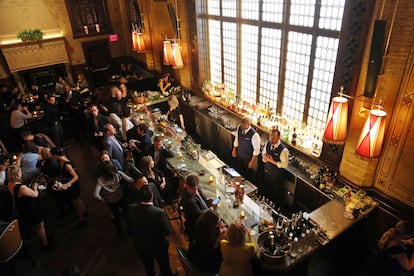 The Campbell Bar, inside Grand Central Terminal.Jefferson Siegel ( NY Daily News / Getty Images)
The Campbell Bar, inside Grand Central Terminal.Jefferson Siegel ( NY Daily News / Getty Images)
While many people call it a station, Grand Central is technically a terminal, so don’t be surprised if a New Yorker corrects you if you use the wrong name.
This terminal is brimming with secrets: from a whispering gallery — where two people standing in opposite corners under the vaulted ceilings can hear each other — to a food market that looks spectacular. There are tennis courts, constellations painted on the station’s ceiling and enormous windows through which — if you look closely — you can see the terminal staff walking by. And, of course, there’s The Campbell Bar, where you can grab a bite to eat. Clearly, Grand Central is a bottomless well of curiosities.
7. Roosevelt Island and its cable car
On a first visit to New York, few people know that Roosevelt Island — a residential island with a rich history — lies between Manhattan and Queens. What’s more, the route to visit it is quite original: you can arrive by cable car and return by boat for almost the same price as the subway, but the experience is completely different.
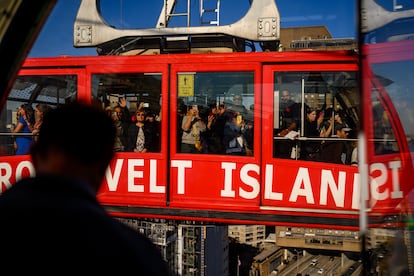 The Roosevelt Island cable car.Roy Rochlin ( Getty Images)
The Roosevelt Island cable car.Roy Rochlin ( Getty Images)
The Roosevelt Island Tramway offers spectacular views of the East River and the Manhattan skyline. It’s one of the few urban cable cars in the world that’s been integrated into a public transportation system.
Once you’re on the island, you can visit the ruins of Smallpox Memorial Hospital, or grab a drink at the rooftop Panorama Room. And, on the way back to Manhattan, the NYC Ferry offers completely different views. All in all, it’s a truly unique route.
8. The resurgence of the speakeasies
During Prohibition, in the 1920s and 30s, speakeasies proliferated. Some have survived to this day, like the legendary Please Don’t Tell (PDT), which is accessed through a phone booth in a hot dog shop. But the oldest is The Back Room, on the Lower East Side, which began operating as a secret bar in 1920. The bartenders still serve cocktails in teacups, just as their predecessors did many years ago, to throw the police off the scent. Stepping inside is like traveling back in time.
The best part is that these bars have become fashionable again. There are new speakeasies constantly popping up, each one more fun to find than the last.
9. The Union Square Metronome and its significance
The Metronome is a piece of public art located in Union Square, which all tourists look at with curiosity. Created by artists Kristin Jones and Andrew Ginzel, it was unveiled in 1999 and consists of several elements. The most striking one is a large digital clock that doesn’t display the traditional time, but rather a countdown of the seconds in a day. The numbers on the left show the hours, minutes and seconds remaining in the day, while those on the right show the hours, minutes and seconds that have passed. In the center, a smaller number indicates hundredths of a second.
The purpose of this work is to invite reflection on the passage of time, the fleeting nature of life and the constant rhythm of the city… and it certainly succeeds! It’s a powerful visual reminder of the relentless march of time.
 The facade of Duane Reade, with the Union Square metronome.Ben Hider ( GETTY IMAGES )10. The secret to restaurants: health ratings
The facade of Duane Reade, with the Union Square metronome.Ben Hider ( GETTY IMAGES )10. The secret to restaurants: health ratings
Before choosing where to eat, you should know this: while New York is famous for its wide range of culinary offerings, few people know that all the restaurants are subject to a strict health rating system. This is indicated by a letter grade displayed at the entrance of each establishment: A, B, or C.
Our personal summary is: if it has an A, go in without hesitation. If the place got a B, isn’t there one nearby with an A? And, if there’s a C, you’re probably not that hungry!
As you can see, New York is much more than its world-famous icons. It’s full of unusual corners, fascinating stories and well-kept secrets. And while we’ve just listed 10, there are countless more.
Sign up for our weekly newsletter to get more English-language news coverage from EL PAÍS USA Edition
